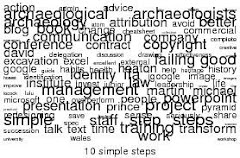Most readers probably visited here looking for a couple of tips for specific but minor problems they had encountered. I hope they will have found something useful, or at least got some pointers to possible solutions. But to stop there is to miss an opportunity. Transformational change requires commitment from the individual, and maybe you are at the point where you are ready to take that step. If so, this section will provide a template for a personal action plan, through which you will identify your goals, define a plan, and subsequently monitor your progress and review your plan. To do this I have developed what I call a Love/hate map.
It is interesting to look at the IFA’s CPD scheme of 2002, which covered similar territory (see the download forms and further information on the IFA Training CPD page. The focus there is on knowledge and experience, directly related to current or near-future work, rather than skills; it is improved skills that provide the best pay-off, and are more likely to be transferable in the future.
Stage 1: Preparation
Projects are usually planned in great detail, even if they are short and simple. This is in complete contrast to how those involved handle their career development, which is left to chance or whim. Obviously it isn’t possible to control which jobs fall vacant, or where and when, but it is possible to have a concept of what your next move is likely to be and what would be needed to succeed. But your career development is something worth investing some time in, so treat it seriously.
Before starting the actual process, it is worth exploring whether there is someone you can share it with. If so, this can make things much more productive and enjoyable. Choosing a buddy is difficult: they must be honest and tactful, as well as trustworthy. It is best is it is not your line manager: they will almost always find the switching of roles between boss and confidante too difficult to handle, especially if your long-term aim is to leave. But find a mentor if you can.
Then you’ll need a journal or file where you can assemble your thoughts, and copies of your cv, job descriptions, and organisational documentation. And some time, undisturbed: getting up early in the morning is a good approach.
Stage 2: Analysis
The first stage is to look at your current work and skills. It is easy to define a post in terms which become a shopping list of tasks, but this isn’t very productive. A much better idea is to draw up a Love / hate map.
Write a list of the ten aspects of your current post you feel most strongly about, with a one-word title. This may be a major functional element of your job, or a small task that excites a reaction (foreboding or anticipation). For example:
Meetings Negotiating with developers and curators
Lectures Formal public speaking
Admin Timesheets, expenses and order forms
Writing Writing publication text
It is quite likely that the things that bother or please you the most are 'soft' skills like interpersonal relations, which tend to fall through the gaps in job-focused training.
Go through the list putting between one and three ticks against those you enjoy, and crosses against those you dislike.
The next stage may require external input (where your buddy/mentor might help, or your last performance appraisal), since you now want to try to decide how effective you are at those tasks, independent of whether you like doing them. Assign ticks and crosses as before, with a different colour pen. (Note that the number of ticks is not crucial and it is pointless to obsess over precise measurement).
Draw a large cross on a piece of paper: label the righthand side “Tasks I love”, the lefthand side “Tasks I hate”; the upper half “Tasks I’m good at”, and the lower half “Tasks I’m bad at”.
Now write onto the grid your ten tasks in the correct position.
Love/hate map showing tasks
This map by itself shouldn’t be telling you anything you don’t already know, but it may help you understand your strengths and weaknesses.
If the bottom left box is full and the top right box is empty, you are in the wrong job. You shouldn’t spend your time doing badly the tasks you hate.
You may be reassured about the tasks in the top left: you may worry about them but they are not damaging your performance.
The tasks in the lower half are the ones which need action. To prioritise them, you should now circle those tasks which are most central or frequent in your work.

Love/hate map showing frequent tasks
Any circled tasks in the bottom left box need to be looked at first; next would be circled tasks in the bottom right box.
This exercise is not dissimilar to other methods of analysis, except that by brining your feelings into the equation it makes the outcomes much more focused, because moving tasks out of the bottom left box will not only improve your output, it will also make you feel much better. The word ‘happiness’ is not much used in management theory, even though it is critical to performance.
Stage 3: Improving performance
Now you know which tasks need attention, you will have to explore ways to improve. This may be as simple as asking your manager or colleagues for advice or help, or reading a book or website; or it may involve formal study. Most managers leave the identification of training needs to the individual, and as long as you have a clear idea of what you want and how to get it, it shouldn’t be difficult to obtain their support. It is worth noting that even for the most expensive taught courses, the main expense is your time.
It is a good idea to draw up a timetable:
Aspect Current performance Priority Action needed Date
Admin Poor High Inhouse training by May 2008
Meetings Fair Medium Remote learning course by July 2008
Supervising Fair Low Inhouse training or formal course by Dec 2008
The timetable should also have a review date (6 months or a year in the future): write it here, and put it in your diary.
Stage 4: Future plans
It will be seen that the action plan has so far dealt with your current work, not the future. This is deliberate: people's instincts about the past and present are quite reliable; their guesses about the future are not. It is possible to use the map to assist in informing your future plan.
Think about your ideal next job; be as specific as possible ("a Project Officer doing watching briefs for a commercial unit", rather than a "Project Officer"). Find a job description of a similar post, and then compare how many of your 10 mapped aspects will be relevant. If they lie mainly in the love/do badly quadrant, you should seek training to address your performance. If they lie mainly in the hate half of the map, you should look for other possible posts with a better fit.
This can then be developed into a timetable as for Stage 3, with a review date.
If you feel that it is time to move on, you should also think about the sort of application an ideal candidate would submit: what qualifications? experience? skills? attitudes? This may well reveal gaps in the evidence you can provide, which you should try to address before you start applying in earnest.
Stage 5: Review
At regular intervals (the last day of the month, or payday, are good milestones), take five minutes to look at your action plan. Are you making progress? Have you changed your mind or found new areas to explore?
Soon enough, your review date will arrive. If you find that your attitudes have changed completely, re-start the process from Stage 1. If not, consider how far you have come. Discuss your plans with your training buddy. Unlike most conversations about people's so-called careers, this should turn out to be a positive and inspiring exercise.
Discussion
It is easy for introspection to become daydreaming, and debate to become whinging. This action plan is intended to provide a structure which should clarify your goals; it contains no great insights, beyond the obvious one that people enjoy jobs which involve doing things they like and are good at.











